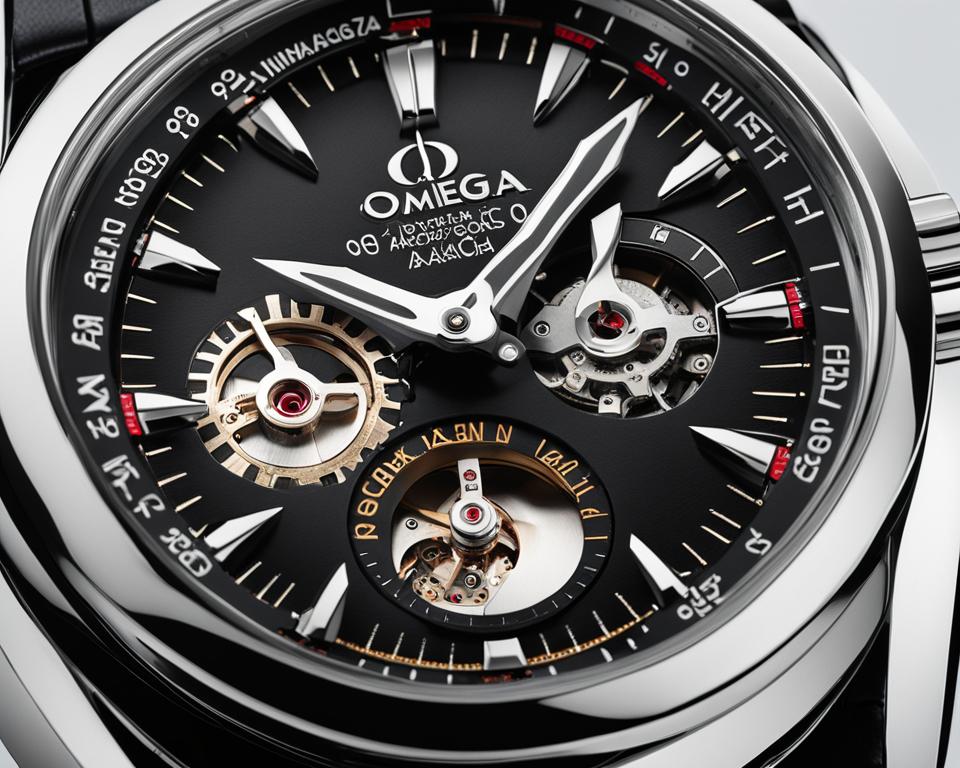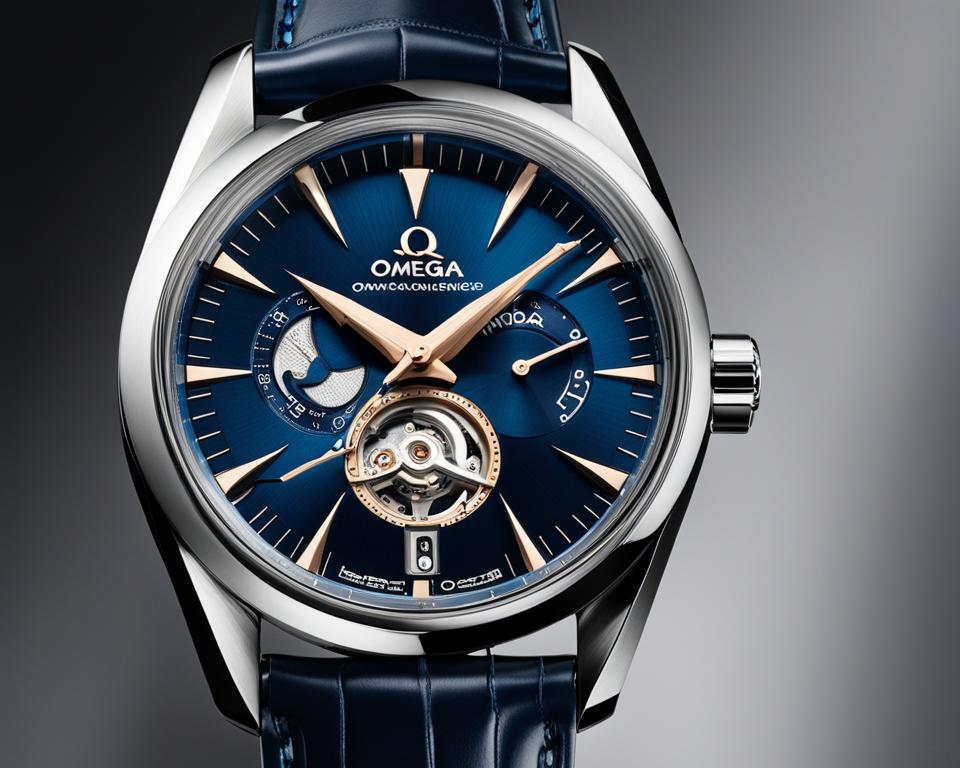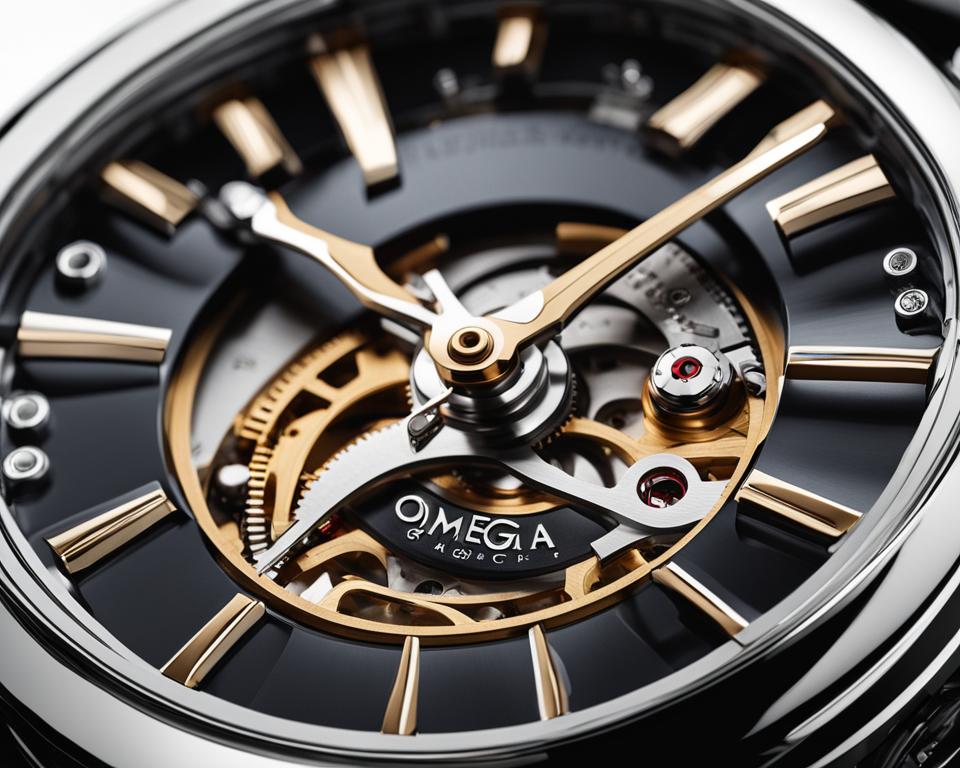The world of luxury watches has been forever transformed with the introduction of Omega’s Co-Axial Movement. This groundbreaking innovation in advanced watch technology has set a new standard for precision, reliability, and craftsmanship. With its innovative watch movements and superior timekeeping capabilities, Omega has solidified its position as a leader in the industry.
Key Takeaways:
- Omega’s Co-Axial Movement revolutionized the world of luxury watches.
- It offers advanced watch technology and innovative movements.
- The Co-Axial Movement provides precise and reliable timekeeping.
- Omega showcases its exceptional craftsmanship and expertise in horology.
- The Co-Axial Movement has established Omega as a leader in Swiss watches.
A Brief History of Timekeeping: The Escapement
In the world of mechanical watches, the escapement is a crucial component that ensures the precise and accurate measurement of time. Before the advent of the Omega Co-Axial Movement, traditional mechanical watches relied on various types of escapements, each with its own advantages and limitations.
The most common type of escapement used in mechanical watches was the lever escapement. It was widely adopted during the industrialization and commercialization of watchmaking. The lever escapement operated by using a lever mechanism to lock and release a toothed escape wheel, allowing the regulated release of energy and the measurement of time. While the lever escapement provided acceptable precision, it required frequent servicing and lubrication to maintain optimal performance.
Another type of escapement, known as the detent escapement, was highly regarded for its superior precision. The detent escapement used a thin, spring-loaded detent to lock and unlock the escape wheel teeth. This design minimized friction and allowed for highly accurate timekeeping. However, the detent escapement was delicate and sensitive to changes in movement and external influences.
Recognizing the limitations of both the lever and detent escapements, George Daniels, a renowned British watchmaker, aimed to create a new escapement that would combine the advantages of both designs while addressing their shortcomings. After years of research and experimentation, Daniels invented the Co-Axial Escapement—the foundation of Omega’s Co-Axial Movement.
The Co-Axial Escapement introduced a revolutionary design that reduced friction and enhanced energy transfer within the watch movement. This innovative escapement significantly improved watch precision and eliminated the need for frequent lubrication, resulting in longer service intervals. Omega’s incorporation of the Co-Axial Escapement in their watches made a breakthrough in the industry, setting a new standard for mechanical timekeeping.
The Co-Axial Movement marked a turning point in the history of timekeeping, showcasing the relentless pursuit of accuracy and innovation in the field of horology. With its superior precision and extended service intervals, the Co-Axial Movement has become synonymous with excellence in watchmaking.
Image:
The Co-Axial Movement: Reduced Friction and Improved Energy Transfer
The Co-Axial Movement developed by Omega Watches Co-Axial Movement is a testament to their commitment to innovation and excellence. This remarkable technology offers reduced friction and improved energy transfer within the watch, resulting in exceptional performance and longevity.
One of the key features of the Co-Axial Movement is its specially shaped escape wheels in the Co-Axial Escapement. These wheels significantly reduce sliding friction, allowing for increased accuracy and efficiency in timekeeping. The reduction in friction also means that the watch requires less frequent lubrication, enhancing its durability and minimizing maintenance needs.
Omega Watches Co-Axial Movement ensures long service intervals between maintenance, providing convenience to watch owners. This allows for extended periods of precise timekeeping without the hassle of frequent servicing.
In addition to reducing friction, the Co-Axial Movement incorporates innovative materials like silicon. Silicon is known for its excellent efficiency and resistance to external influences, further enhancing the performance and durability of Omega watches.
The minimal backlash in the Co-Axial Movement is another notable feature that contributes to its accuracy. With minimal backlash, the energy transmission is precise and immediate, resulting in reliable timekeeping.

In summary, the Co-Axial Movement from Omega Watches Co-Axial Movement is a breakthrough in watchmaking technology. With reduced friction, improved energy transfer, innovative materials, and minimal backlash, it achieves exceptional precision, durability, and long service intervals. Omega’s commitment to innovation and excellence is evident in the ingenuity of the Co-Axial Movement.
Omega’s Collaboration with the Co-Axial Movement
Omega, a prominent player in the watch industry, was quick to recognize the potential of the Co-Axial Movement and wasted no time in collaborating with George Daniels to commercialize this innovative technology. This partnership marked a significant milestone in the watch industry and showcased Omega’s commitment to pushing the boundaries of innovation.
The introduction of the Co-Axial Escapement in the Omega De Ville Co-Axial was a groundbreaking moment that revolutionized watchmaking. With its enhanced precision and reliability, the Co-Axial Movement quickly gained recognition and admiration from watch enthusiasts worldwide.
Building on the success of the De Ville Co-Axial, Omega expanded the use of the Co-Axial Movement across their watch collections, including the Seamaster, Speedmaster, and Constellation lines. This expansion allowed a wider audience to experience the superior performance and cutting-edge technology of the Co-Axial Movement.
As a testament to their commitment to excellence, Omega also introduced the Certified Master Chronometer standard, which combines the remarkable Co-Axial Escapement with rigorous testing for magnetic resistance, water resistance, and overall precision. This certification assures buyers of the exceptional quality and performance of Omega watches.
Undeterred by their successes, Omega continues to drive ongoing innovation in the Co-Axial Movement. They continuously incorporate advanced materials and introduce new complications to their watches, ensuring that the Co-Axial Movement remains at the forefront of watchmaking technology.

The History of George Daniels and the Co-Axial Movement
George Daniels, a British watchmaker, dedicated years of his life to perfecting the Co-Axial Movement. Dissatisfied with the limitations of the traditional lever escapement, Daniels sought to create a new escapement that would improve accuracy and reduce the need for maintenance. His innovative mindset and passion for horology led him to develop the Co-Axial Escapement, a groundbreaking concept in watchmaking.
Daniels patented his invention in 1980, and in 1999, Omega partnered with him to introduce the Co-Axial Escapement in their watches. This collaboration marked a significant milestone in the history of watchmaking, as the Co-Axial Movement revolutionized the industry with its precision and innovation.
George Daniels’ contribution to the world of watchmaking continues to be celebrated, and his legacy is evident in the performance and craftsmanship of Omega Watches Co-Axial Movement. His innovative escapement design has set a new standard for precision and reliability in mechanical timepieces, further establishing Omega as a leader in the field of horology.
Omega’s Co-Axial Movement Innovations
| Year | Innovation |
|---|---|
| 1980 | George Daniels patents the Co-Axial Escapement |
| 1999 | Omega collaborates with George Daniels to introduce the Co-Axial Escapement in their watches |
| 2007 | Introduction of the Certified Master Chronometer standard |
| 2015 | Integration of antimagnetic technology in Co-Axial Movements |
| 2020 | Expansion of the Co-Axial Movement across Omega’s watch collections |
Omega’s Integration of the Co-Axial Escapement
Omega’s collaboration with the Co-Axial Movement represents a milestone in watchmaking history. The integration of the Co-Axial Escapement into the Omega De Ville Co-Axial marked its commercial debut in wristwatches, revolutionizing the industry. Combining innovative technology and precise watch movements, Omega expanded the use of the Co-Axial Movement across its watch collections.
The introduction of the Co-Axial Escapement in the Omega De Ville Co-Axial was a testament to the versatility and adaptability of this innovative technology. It quickly gained popularity among watch enthusiasts and allowed Omega to showcase the exceptional performance of the Co-Axial Movement in various watch designs.
| Expansion | Versatile | Certified Master Chronometer |
|---|---|---|
| Incorporated into a wide range of Omega watches | Adaptable to different styles and collections | Rigorous testing for magnetic resistance, water resistance, and overall precision |
| Seamaster | Speedmaster | Constellation |
| Suitable for sports watches | Perfect for dress watches | Exemplifies Omega’s commitment to quality |
Omega’s dedication to precision and quality led to the introduction of the Certified Master Chronometer standard. This certification combines the Co-Axial Escapement with rigorous testing, ensuring that the watch meets the highest standards in terms of magnetic resistance, water resistance, and overall precision.
With ongoing innovation, Omega continues to introduce variations of the Co-Axial Movement, incorporating advanced materials and adding new complications to their watches. This relentless pursuit of excellence allows Omega to maintain its position as a leader in the watch industry, consistently pushing the boundaries of watchmaking technology.
The Legacy of the Co-Axial Movement in Watchmaking
The Co-Axial Movement introduced by Omega Watches has revolutionized the watch industry, leaving a lasting impact on the world of mechanical timekeeping. With its commitment to precision, innovation, and excellence, Omega has set a new standard for watchmaking. The integration of the Co-Axial Escapement in Omega’s timepieces has showcased their dedication to pushing the boundaries of technology.
The Co-Axial Movement has not only improved the accuracy and reliability of mechanical watches but has also solidified Omega’s position as a leader in the watch industry. By constantly refining the Co-Axial technology, Omega has demonstrated their commitment to providing their customers with exceptional timepieces.
Omega’s legacy extends beyond the introduction of the Co-Axial Movement. Their ongoing pursuit of innovation and excellence has shaped the future of mechanical timekeeping. As a result, watch enthusiasts and collectors around the world recognize Omega Watches as a symbol of precision and craftsmanship.
FAQ
What is the Co-Axial Movement developed by Omega?
The Co-Axial Movement is an innovative watch movement developed by Omega, a renowned Swiss watchmaker. It revolutionized the world of timekeeping with its advanced technology and precise, reliable performance.
What are the advantages of the Co-Axial Movement?
The Co-Axial Movement offers superior precision and longer service intervals compared to traditional watch movements. Its reduced friction design and improved energy transfer contribute to its accuracy and efficiency. It also incorporates innovative materials for enhanced performance and durability.
How did Omega collaborate with the Co-Axial Movement?
Omega recognized the potential of the Co-Axial Movement and partnered with British watchmaker George Daniels to commercialize this innovative technology. The Co-Axial Escapement was first introduced in the Omega De Ville Co-Axial and later expanded across their watch collections.
What is the history of George Daniels and the Co-Axial Movement?
George Daniels, a British watchmaker, invented the Co-Axial Escapement to improve accuracy and reduce the need for frequent maintenance. He patented his invention in 1980, and in 1999, Omega collaborated with him to introduce the Co-Axial Escapement in their watches. Daniels’ legacy is evident in the precision and innovation of the Co-Axial Movement.
How did Omega integrate the Co-Axial Escapement?
Omega integrated the Co-Axial Escapement into their watches, starting with the Omega De Ville Co-Axial. This innovative technology quickly expanded across their watch collections, showcasing its versatility and adaptability. Omega also introduced the Certified Master Chronometer standard, combining the Co-Axial Escapement with rigorous testing for magnetic resistance, water resistance, and overall precision.
What is the legacy of the Co-Axial Movement in watchmaking?
The Co-Axial Movement has left a lasting legacy in the watch industry. Its revolutionary technology has set a new standard for precision and reliability in mechanical timekeeping. Omega’s integration of the Co-Axial Escapement and ongoing innovation continue to push the boundaries of watchmaking, cementing their position as a leader in the industry.

Leave a Reply